Are you a small business owner, or have you always wanted to start your own independent clothing brand? Imagine putting all your efforts into designing an amazing garment print, ready to put out into the market, only to find your garment labels don’t comply with regulations. Whatever you’re here for, Innotex Transfers can help you with a beginner’s guide to clothing labels.
Consumers are reliant on the labels within their clothing to help keep them looking their best for as long as possible, so it’s imperative to protect your brand and give the consumer confidence in your clothing by helping them to do just that. There are several labelling related factors that must be taken into consideration before selling your garments, all of which will be covered throughout this article.
Sewn In vs Heat Transfers
The material you chose is more or less going to impact the comfort of your garments, leading to the satisfaction of your customers. Sewn in labels generally come in two forms: woven labels and satin printed labels. Heat transfers, however, are available in many finishes depending on the look and feel you’re going for. We’ve listed below the differences between sewn in and heat transfers, so you can determine the right choice for you.
SEWN IN | HEAT TRANSFER LABEL | |
Typical costs | 15p | 4p |
Minimum quantity | 5,000 per size | 50-100 pieces |
Application time | 60-80 garments per hour | 400+ per hour |
Application skill required | Moderate sewing skills | None |
Wash resistance | Domestic/Industrial | Domestic/Industrial |
Design limitation | Any design is possible | 4 colours |
Let’s go through this in more detail. You know the hook inside a garment that you hang on your bedroom door, or your coat rack, or wherever you hang them? Those are often sewn in fabric tags (and you probably have them in different designs at home). Though the practicality of garment care is better, sewn-in labels are often easily torn, resulting in damage to garment seams. Some sewn in labels are designed as a loop, some come in an angular fold, while some are sewn edge-to-edge. Below provides a visual of how stitching works for different label finishes.
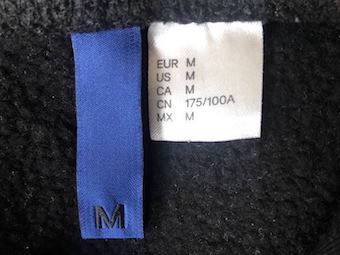
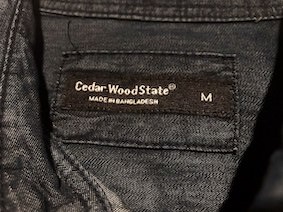
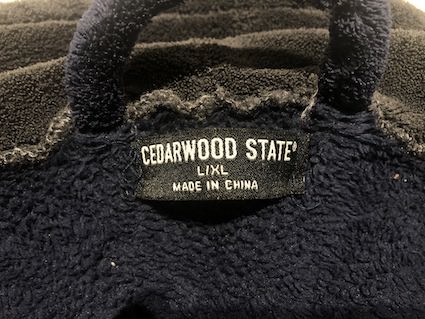
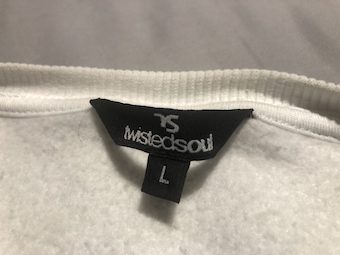
Check out the prices for single colour mixed sheet transfers.
Sewn in woven labels can be immensely detailed if they are woven correctly. With that said, it’s not the best material for everyone and you’re likely to have to get them manufactured by a specialist company.
Have you yourself, ever experienced discomfort from a label so irritating, that you simply stop wearing the garment? This is down to the material and physicality of sewn-in labels – you wouldn’t have this issue with printed labels because you can’t feel them – they bond directly with the surface of the fabric. This issue is more common with garments such as t-shirts and undergarments as they have physical contact with the skin. Having said that, some of the most popular clothing brands such as Fruit of the Loom, Gildan and Russell Athletic manufacture garments that allow for labels to be detached and replaced, which is great for businesses that are looking to improve their brand identity, so you can decide on sewn in or transfer labels.
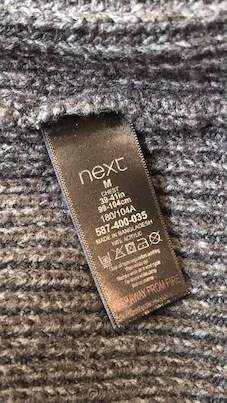
Advantage of Heat Transfer Clothing Labels Over Sew-in
There are several advantages of heat transfer clothing labels when compared with sew-in labels.
Ease of Application
Though heat transfer labels don’t give garments the practicality of hanging onto hooks, they have the advantage of the ease of application, while sewn in labels require some skill in … you guessed it … sewing. This can be a lengthy process, yet heat pressed labels are quick and easy, giving the whole garment a clean finish while still providing all the information needed on the label. Printed labels are generally favoured when it comes to comfort as there’s no tag bugging the consumer wearing the apparel. Whichever method piques your interest, you’re bound to find one that suits you.
Heat Transfer Labels are Cheaper
It’s good to remember that transfer labels are cheaper, easier to apply and can be produced in much larger quantities in a shorter amount of time than sewn in labels. Unless you have a massive production team that specialises in sewing labels, you’ll find it very time consuming and counter-productive to go for this method. So if you are that independent clothing brand or even part of a large corporation, transfer labels would take away a lot of hassle. One thing to note is that most direct clothing decorations shouldn’t be ironed over directly in order to preserve their appearance.
You can learn more about this by reading the following blog: How to Use a Heat Press Machine For T-shirt Printing: A Step-by-Step Guide
Big Brands Use Both Methods
Take H&M for example. Their garments are sold with loads of different types of labels. Including transfer AND sewn-in labels. Their t-shirts are branded with heat pressed labels yet their garments such as hoodies and sweatshirts sport a sewn in label in the style of a loop fold. It really depends on the type of product you’re selling that can also factor into your decision in clothing labels.
What Is Required by Law on a Clothing Label in the UK
Now let’s get onto the importance of label information. Without this, it doesn’t matter if your labels are comfortable or flashy, because you won’t be able to sell your products without the correct information. Different countries around the world have different requirements when it comes to garment labelling, so make sure you fully research the requirements of each market you sell into.
International Association for Textile Care Labelling
Ever heard of GINETEX? They are known as the international association for textile care labelling. Translation: If you want to trade garments pretty much anywhere, you must follow all their regulations. GINETEX has trademarked 5 symbols that are required in the EU. Due to Brexit, some regulations may change in the future, but for now, the UK and EU have identical regulations. These symbols represent; washing, drying, ironing, bleaching and professional care. The UK and EU don’t have to comply with regulations surrounding fibre content and country of origin because they aren’t mandatory unless you are trading outside of those areas. If you’re a commercial company such as a wholesaler or importer, you REALLY need to stay updated on any changes to the guidelines as this affects your trading the most.
Rules Regarding Flammability
Despite GINETEX’s impact on the industry, there are rules regarding flammability which is not outlined in their regulations, which are just as important. Again, commercial companies would need to follow this rule: if your garments are made in the EU or UK, All children’s nightwear requires a flammability warning. Missing out on this piece of information can be extremely damaging to your business, as the rule on this is pretty strict. Be sure to keep updated on the rules depending on trading areas and manufacturing areas so you don’t fall into a sticky situation.
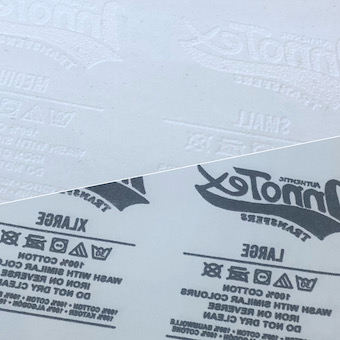
How Can Innotex Transfers Help With Printed Clothing Labels
No need to worry about making your own clothing labels. As a specialist textile labels manufacturer, Innotex Transfers can help with the design and production of your brand of companies neck labels. There are many types of transfers available and we’d happily help find the right one for your next project. Why not request one of our FREE transfer sample packs below to see how our transfers can add value to your brand.
Bonus Tip: If you need help, we have got the ultimate guide to heat press machine
Hopefully, you’ve gained tons of information from this guide to move on to garment labelling and trading. It can sound a bit daunting at first, but with Innotex Transfers by your side, we’ll ease off the pressure and get you where you need to be. If you ever need us, just give our team a call at 020 3617 8710 during our office hours or email us at sales@innotextransfers.com about any queries you may have regarding our services. Innotex is happy to help!


